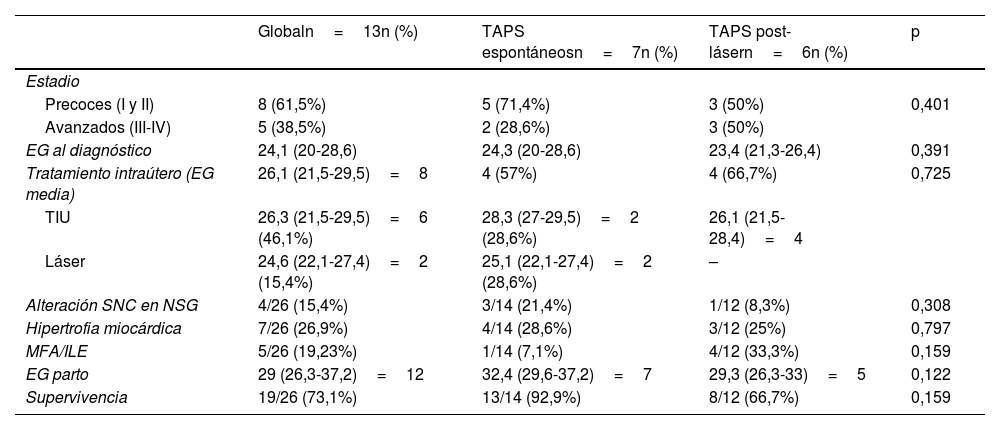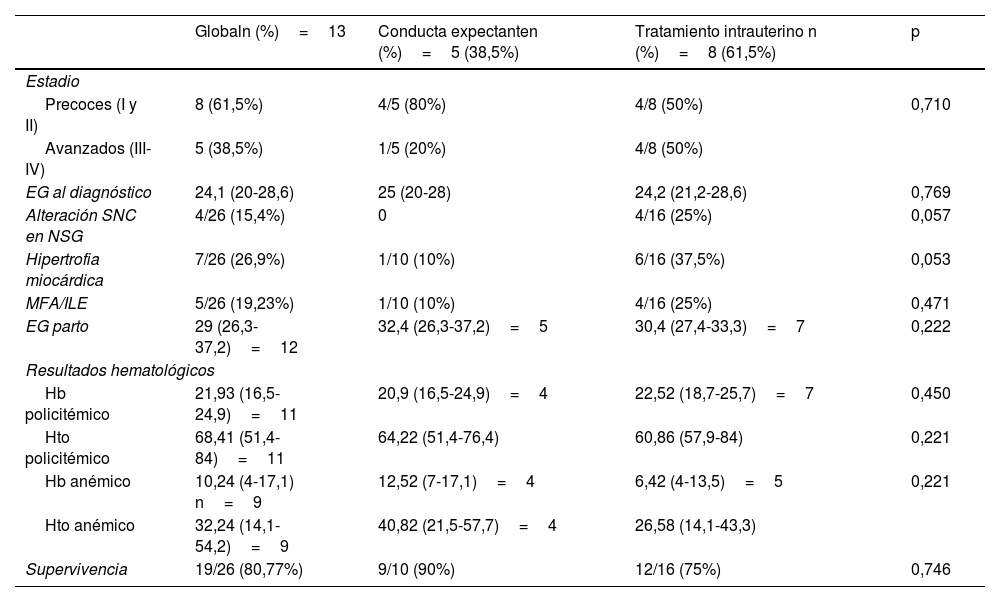El objetivo de este trabajo consiste en describir y analizar los resultados perinatales de una serie de casos de anemia-policitemia (TAPS) seguidos y tratados en un centro de referencia en Medicina Fetal, en términos del tipo TAPS y la conducta prenatal aplicada.
MétodosAnálisis estadístico descriptivo e inferencial con el programa IBM SPSS Statistics.
ResultadosSe diagnosticaron 13 casos de TAPS en un total de 510 gestaciones monocoriales. La mayoría de TAPS espontáneos se diagnosticaron en estadios precoces (5 casos), mientras que, en TAPS posláser, 3/6 casos se diagnosticaron en estadios avanzados.
Cuatro fetos (4/26; 15,4%) presentaron alteraciones en la neurosonografía, 3 (3/14; 21,4%) en TAPS espontáneos y uno (1/12, 8,3%) en TAPS posláser (p = 0,308).
Se detectó hipertrofia miocárdica en 7 fetos, 5 (71,4%) de los cuales correspondían a TAPS en estadios avanzados. Cuatro eran TAPS espontáneos (4/14; 28,6%) y 3 TAPS posláser (3/12; 25%) (p = 0,797). Ocho casos (8/13; 62,5%) precisaron algún procedimiento de terapia fetal.
Se produjeron 3 muertes fetales anteparto y una pareja decidió interrupción legal del embarazo (19,23%). Las 5 pérdidas se produjeron en estadio IV (p=0,008).
La supervivencia global fue del 80,8% (21/26 recién nacidos vivos). No hubo diferencias significativas en función del tipo TAPS (p = 0,159) y la conducta prenatal adoptada (p = 0,746).
ConclusionesEl TAPS espontáneo es, por tanto, una entidad clínica con un impacto en los resultados perinatales similar al posláser. Parece que la conducta expectante y el láser consiguen mayor edad gestacional al nacimiento.
The aim of this paper is to describe and analyze the perinatal outcomes of a series of TAPS cases followed and treated in a Fetal Medicine referral center, in terms of the type of TAPS and the prenatal behavior applied.
MethodsDescriptive and inferential statistical analysis with IBM SPSS Statistics software.
ResultsThirteen cases of TAPS were diagnosed in a total of 510 monocorial gestations. Most of the spontaneous TAPS were diagnosed at early stages (5 cases), whereas, in post-laser TAPS, 3/6 cases were diagnosed at advanced stages.
Four fetuses (4/26; 15.4%) presented alterations in neurosonography, 3 (3/14; 21.4%) in spontaneous TAPS and one (1/12, 8.3%) in post-laser TAPS (P=0.308).
Myocardial hypertrophy was detected in 7 fetuses, 5 (71.4%) of which corresponded to advanced stage TAPS. Four were spontaneous TAPS (4/14; 28.6%) and 3 were post-laser TAPS (3/12; 25%) (P=0.797). Eight cases (8/13; 62.5%) required some fetal therapy procedure.
There were 3 antepartum fetal deaths and one couple decided to legally terminate the pregnancy (19.23%). All 5 losses were stage IV (P=0.008).
Overall survival was 80.8% (21/26 live newborns). There were no significant differences according to the type of TAPS (P= 0.159) and the prenatal behavior adopted (P=0.746).
ConclusionsSpontaneous TAPS is therefore a clinical entity with an impact on perinatal outcomes similar to post-laser. It seems that expectant management and laser achieve higher gestational age at birth.









